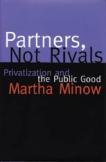A Daring Integration
What are public issues? What organizations are best prepared to address them? Do we have a welfare problem or a poverty problem? Is education a concern because of failing schools or failing social equity?
These important questions have become increasingly perplexing, especially if we consider the central points of Harvard law professor Martha Minow’s new work, Partners, Not Rivals: Privatization and the Public Good. Minow raises many provocative issues: What happens when private companies, nonprofit agencies, and religious groups manage what government used to managein education, criminal justice, legal services, and welfare programs? As for-profit companies run schools, where will they make their profit margin? As religious groups provide job training and food stamps, will they respect public rules against discrimination and forcing people to pray?
In Partners, Not Rivals, Minow highlights the increasingly permeable boundaries that have characterized public and private matters. Education may be a public good, but individuals are the immediate beneficiaries. Lack of adequate health care has community as well as personal consequences. Poverty affects individuals, but it is also a public issue because of labor, customer and economic development implications.
These are not simple matters, although some public policy makers may promote simple solutions. Some contend that communities should care for their own. Others believe that government should care for all, or at least offer a safety net for all who need it. Still others argue that individual problems are an individual responsibility.
Regardless of ultimate responsibility, the key for Minow is that public values should accompany public money. She proposes values such as democracy, pluralism and accountability as standards for determining how public money should be allocated to private organizations, including religious ones.
Minow explores schooling, welfare and faith-based initiatives in careful detail. (Her thoughtful book also extends to health care and legal services for the poor, among other issues.) She writes with concern and conviction about the tensions between private choices and community benefit, and how these tensions play out in public policy.
While consumer choice may be the driving force behind school vouchers, Minow wonders about the impact of vouchers on increasingly diverse student bodies, including those with disabilities and limited English proficiency, noncitizens, the homeless, and migrants. She notes that the voucher debate often ignores admission standards or transportation problems, and that competition is no guarantee of educational quality. While she applauds the idealized concept of school choice, she also worries about racial segregation and funding inequities in public schools, the lack of adequate space in parochial and private schools for all who might wish to use vouchers and the fragility of equality as a public value.
Welfare is another policy arena that magnifies the public-private quandary. The Personal Responsibility and Work Opportunity Reconciliation Act of 1996 (so-called welfare reform) contains charitable choice provisions that permit states to work more directly with religious (faith-based) organizations. These provisions eventually included Head Start and children’s health programs, among others. Congress then passed the Community Opportunities, Accountability, and Training and Educational Services Act of 1998, which enabled pervasively sectarian organizations to receive public funding. In 2001 the White House established an Office of Faith-Based Initiatives.
These welfare-related developments opened the public funding door for churches and other religious entities. With that opening has come a renewed debate over how church and state relate to each other. In Minow’s view, vouchers for welfare services may be the answer, thus allowing an individual to choose one provider over another.
But what is the true nature, and public implication, of a private choice? In the case of education, Minow suggests that school vouchers are probably acceptable, assuming that not all vouchers are used at religious schools. In the case of charitable choice for welfare services, she asks whether vouchers used at pervasively sectarian organizations might promote a particular religion. (To complicate matters even more, contrast the Catholic Charities USA embrace of charitable choice with Southern Baptist resistance. Add consideration of groups like the Church of Scientology and the Nation of Islam, and see how confusion might reign.)
Beyond specific individual benefits, Minow reminds us of broader matters. She wonders whether widespread use of school vouchers will undermine public education and diminish our sense of democratic community. She is ambivalent about how genuine a choice might be if the closest or only nonpublic welfare provider is a religious one. She asks if religious and public values regarding gender, privacy and discrimination can be reconciled. Most important, she cautions that religious groups cannot fill in the holes in a gouged public safety net; nor can they develop the capacity to educate all American children.
Instead of presenting a simple prescription, Minow promotes a daring system of private and public partnerships based on the creative integration of tax policies, government contracts and vouchers, all expressive of democracy and pluralism as public values.
Readers of America will have additional concerns that go beyond the scope of this book. What happens when a church becomes a vendor of government-financed services? Should the same measures of public accountability and financial transparency that pertain to secular nonprofits also be applied to churches? And will public money cause religious leaders to pull back their prophetic punches because they fear loss of funding if they question government officials over matters of public policy?
In the end, Minow’s argument for public-private partnership rather than rivalry is a compelling one: We cannot leave the needs of those who cannot pay to the vagaries of politics and to the preferences of those who can command legislative and judicial majorities. But she believes such partnerships must be forged with a non-negotiable caveat: Public values should accompany public dollars.
This article also appeared in print, under the headline “A Daring Integration,” in the January 20, 2003, issue.








